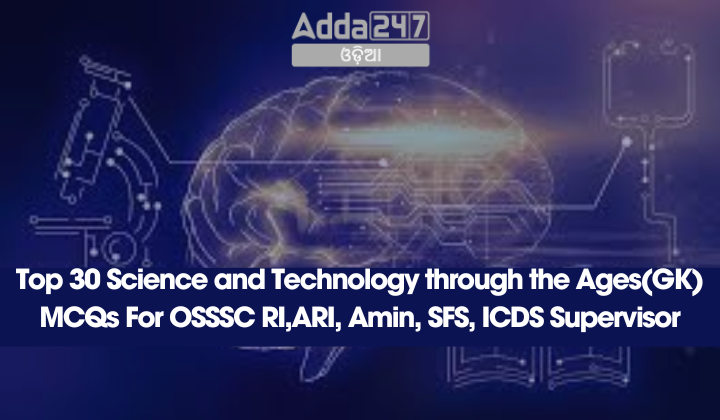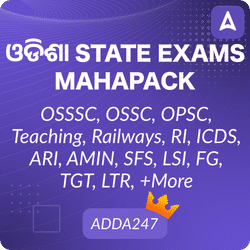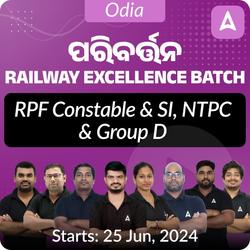General knowledge in science and technology is essential for various competitive exams, including OSSSC RI, ARI, Amin, SFS, and ICDS Supervisor exams. Here is a curated list of 30 multiple-choice questions (MCQs) that cover significant milestones and inventions in science and technology through the ages.
Top 30 Science and Technology through the Ages(GK) MCQs For OSSSC RI,ARI, Amin, SFS, ICDS Supervisor
- Which ancient Indian mathematician wrote the earliest book on mathematics, Shulbasutra, around the 6th century BC?
a) Aryabhata
b) Brahmagupta
c) Baudhayana
d) Bhaskara I
Answer: c) Baudhayana - What is the meaning of the term “Bijaganita” in ancient Indian mathematics?
a) Geometry
b) Arithmetic
c) Algebra
d) Astronomy
Answer: c) Algebra - In which century did Apastamba introduce the concepts of practical geometry involving different angles?
a) 1st century BC
b) 2nd century BC
c) 5th century AD
d) 7th century AD
Answer: b) 2nd century BC - Aryabhata’s book “Aryabhatiya” contains sections on several subjects. Which of the following is NOT one of them?
a) Number theory
b) Chemistry
c) Geometry
d) Astronomy
Answer: b) Chemistry - Who introduced the concept of zero as a number in his book “Brahmasputa Siddhanta”?
a) Aryabhata
b) Bhaskara I
c) Brahmagupta
d) Mahaviracharya
Answer: c) Brahmagupta - Which ancient text is considered the earliest Indian text entirely dedicated to Mathematics?
a) Aryabhatiya
b) Siddhanta Shiromani
c) Ganit Sara Sangraha
d) Lilavati
Answer: c) Ganit Sara Sangraha - Bhaskara II’s book “Siddhanta Shiromani” is divided into four sections. Which of the following is NOT one of them?
a) Lilavati
b) Bijaganita
c) Goladhyaya
d) Jyotisa
Answer: d) Jyotisa - What unique method for solving algebraic equations was introduced by Bhaskara II in his book Lilavati?
a) Factorization method
b) Matrix method
c) Chakrawat method
d) Substitution method
Answer: c) Chakrawat method - Which Persian scholar translated the book “Lilavati” into Persian in the court of Akbar?
a) Al-Khwarizmi
b) Faizi
c) Omar Khayyam
d) Avicenna
Answer: b) Faizi - Which ruler set up five astronomical observatories in different cities including Delhi and Jaipur?
a) Feroz Shah Tughlaq
b) Sawai Jai Singh
c) Akbar
d) Feroz Shah Bahamani
Answer: b) Sawai Jai Singh - Who were the practitioners of medicine given divine status during Vedic times?
a) Charaka
b) Sushruta
c) Ashwini Kumars
d) Agnivesa
Answer: c) Ashwini Kumars
Explanation: In the Vedic times, Ashwini Kumars were revered as divine practitioners of medicine. - Which Veda is the first to mention diseases, their cures, and medicines?
a) Rig Veda
b) Yajur Veda
c) Sama Veda
d) Atharva Veda
Answer: d) Atharva Veda
Explanation: Atharva Veda is the earliest Vedic text mentioning diseases and their cures, attributing illnesses to demons and spirits. - Who is considered the Father of Ayurveda and authored the Charak Samhita?
a) Charaka
b) Sushruta
c) Atreya
d) Agnivesa
Answer: a) Charaka
Explanation: Charaka is hailed as the Father of Ayurveda and is the author of the Charak Samhita, focusing on medicinal plants and herbs. - Which ancient Indian text deals with surgery and is attributed to the Father of Surgery?
a) Charak Samhita
b) Atharva Veda
c) Sushruta Samhita
d) Sarangdhara Samhita
Answer: c) Sushruta Samhita
Explanation: The Sushruta Samhita, attributed to Sushruta, the Father of Surgery, is a comprehensive treatise on surgery. - What are the three Doshas according to Charak Samhita that determine the functioning of the human body?
a) Blood, flesh, and marrow
b) Bile, phlegm, and wind
c) Heart, liver, and kidney
d) Brain, nerves, and muscles
Answer: b) Bile, phlegm, and wind
Explanation: Charak Samhita describes the three Doshas—bile, phlegm, and wind—as crucial elements that affect the human body’s functioning. - Which element among the panchbhootas is associated with the sense of smell?
a) Fire (Agni)
b) Earth (Prithvi)
c) Water (Apa)
d) Ether (Akash)
Answer: b) Earth (Prithvi) - Which Buddhist philosophers replaced ether with which new elements in their theory?
a) Air, Water, and Earth
b) Life, Joy, and Sorrow
c) Vision, Feeling, and Taste
d) Earth, Fire, and Water
Answer: b) Life, Joy, and Sorrow - Who were the ancient Indian philosophers that first conceived the idea of atoms?
a) Nagarjuna and Varahamihira
b) Kanada and Pakudha Katyayana
c) Aryabhata and Brahmagupta
d) Patanjali and Panini
Answer: b) Kanada and Pakudha Katyayana - What term did Kanada use to describe the smallest indestructible particle of matter?
a) Atom
b) Parmanu
c) Kana
d) Rasadanya
Answer: c) Kana - In ancient India, chemistry was known by several names. Which of the following was NOT one of them?
a) Rasayan Shastra
b) Rasatantra
c) Rasa Vidya
d) Jyotish Shastra
Answer: d) Jyotish Shastra - Which famous ancient Indian metallurgical monument has not rusted even after thousands of years?
a) Iron Pillar of Mehrauli
b) Qutub Minar
c) Charminar
d) Statue of Unity
Answer: a) Iron Pillar of Mehrauli - What did Nagarjuna primarily focus on in his treatise Rasaratnakara?
a) Metallurgy and alchemy
b) Astronomy and astrology
c) Medicine and surgery
d) Mathematics and geometry
Answer: a) Metallurgy and alchemy - Which city was NOT mentioned as a center for paper production in medieval India?
a) Kashmir
b) Patna
c) Murshidabad
d) Delhi
Answer: d) Delhi - Who is credited with the discovery of attar of roses?
a) King Vikramaditya
b) Mother of Noorjahan
c) Varahamihira
d) Aryabhata
Answer: b) Mother of Noorjahan - Varahamihira, an ancient Indian scientist, made significant contributions to which fields?
a) Astronomy and Astrology
b) Chemistry and Metallurgy
c) Medicine and Surgery
d) Geology, Hydrology, and Ecology
Answer: d) Geology, Hydrology, and Ecology - Which ancient text provides detailed information on shipbuilding techniques in ancient India?
a) Arthashastra
b) Yukti Kalpa Taru
c) Ramayana
d) Mahabharata
Answer: b) Yukti Kalpa Taru - What were the two main classes of ships mentioned in Yukti Kalpa Taru?
a) Sarvamandira and Madhyamandira
b) Samanya and Vishesha
c) Dirgha and Unnata
d) Agramandira and Vata Vastra
Answer: b) Samanya and Vishesha - Which type of ship had a long and narrow hull according to Yukti Kalpa Taru?
a) Sarvamandira
b) Madhyamandira
c) Dirgha
d) Unnata
Answer: c) Dirgha - What was the term used for the sail of a ship in ancient Sanskrit terminology?
a) Nava Bandhan Kilaha
b) Jeni Pata
c) Vata Vastra
d) Machayantra
Answer: c) Vata Vastra - What type of vessels were referred to as Agramandira in the Yukti Kalpa Taru?
a) Ships with cabins extending from one end to another
b) Pleasure trip vessels
c) Warfare vessels
d) Vessels used for royal voyages
Answer: c) Warfare vessels










